Thoughts on the good, the true, the beautiful and raising a big bunch of kids.
Thursday, May 28, 2009
God or the Girl: Young men choose between the priesthood and marriage
It was filmed for the cable television network A&E, as a reality/documentary show about four young men who are trying to discern whether or not they have a call to the Roman Catholic priesthood. The title is a little misleading, as only one of the young men is actively dating a girl (and he quickly chooses the girl). Another young man has put off his relationship with his girlfriend so that he can have time to discern more wisely. Another has a hard time getting a girlfriend (which elicits some groans from my girls, who were quickly rooting for a particular girl to NOT date him), and another young man (perhaps the most handsome of them all) has given up his successful career and half-million dollar condo and girlfried he wanted to marry in order to be a FOCUS missionary and test his call to the priesthood.
We were thoroughly engrossed in the five episodes, despite the annoyance of having the segments recap the previous episodes since this was originally made for television. Even my husband stayed up late to watch the final episode where the three remaining young men "reveal" their decisions. So as not to spoil the show, I won't tell you how they choose, but you'll be able to figure it out...at least for all but one of them, and his decision really isn't surprising either.
The series encouraged me to up my prayers for vocations and for those who are called to be priests because it is so obviously a supernatural vocation that can't be sustained by will of man alone (e.g. the Fr. Cutié scandal).
My two youngest, who were adopted from Guatemala around the age of 2 and who have no memories of their native land, were enchanted by the lovely, though realistic, images of the heartbreaking poverty in Guatemala, as seen through the eyes of the FOCUS missionary. I played that portion of the DVD especially for them to see the conditions in Guatemala and to inspire them to do something to help the people there when they grow up. The missionary priest from India shown in the series cares for a mission plus 60 remote villages. He is able to visit each village only once every 3 months...but that is more often than his predecessor, who was only able to visit them once a year. Nevertheless, the Guatemalan people are so joyful and so thankful for anyone who comes to visit them and they share what little they have with the priest and the young missionary that the missionary is deeply changed, and I believe those who watch this video will also be deeply changed.
I highly recommend God or the Girl for families, for young men, for youth groups and for anyone who is interested in priestly vocations.
P.S. I almost wish I hadn't watched the "special features" on the DVD. Apparently, a fifth young man was filmed but didn't make the cut for the final tv special, and with good reason. He comes across as a very confused and unconfident young man, despite also being a FOCUS missionary. He even goes so far as to see a "life coach" in Boulder, Colorado who makes him go sky diving in order to boost his self-esteem. He is akward on a date with a young lady, who looks miserable thorought the ordeal and he is a terrible public speaker.Even his fellow FOCUS missionaries groan and roll their eyes when they have to deal with him. Watch at your own peril.
Washing with plain water better than hand sanitizers, say researchers
Guess what? They found that washing in plain water removed an average of 96% of the norovirus placed on the fingers of subjects, while using an antibacterial liquid soap with water removed about 88% and the alcohol-based sanitizer removed only about 46% of the virus from the volunteers' fingers.
I was skeptical too, so here's the link to the American Society for Microbiology so you can read it yourself!
Hmmm...I'm using the antibacterial stuff. Maybe plain old soap works just as well or better?
Wednesday, May 27, 2009
A Pilgrimage for Mary in May
 Six of us went on a walking pilgrimage last Friday of Memorial Day weekend. We decided to walk from Arvada to downtown Denver, a distance of a little over 8 miles. We parked at a commuter lot in Arvada so that we could take the RTD home again. Our plan was to leave Arvada early enough so that we could make it to the Cathedral of the Immaculate Conception in time for noon Mass. Unfortunately, we left about an hour after we had intended to leave, so we were compelled to begin our hike with a brisk walking pace.
Six of us went on a walking pilgrimage last Friday of Memorial Day weekend. We decided to walk from Arvada to downtown Denver, a distance of a little over 8 miles. We parked at a commuter lot in Arvada so that we could take the RTD home again. Our plan was to leave Arvada early enough so that we could make it to the Cathedral of the Immaculate Conception in time for noon Mass. Unfortunately, we left about an hour after we had intended to leave, so we were compelled to begin our hike with a brisk walking pace. We began on urban sidewalks, passing by quaint houses with lovely gardens.
We began on urban sidewalks, passing by quaint houses with lovely gardens. We crossed over Wadsworth Boulevard on the new Grandeview overpass.
We crossed over Wadsworth Boulevard on the new Grandeview overpass.
Walking along Grandview Avenue in Arvada.
 Walking enables you to see things you wouldn't normally see from a car.
Walking enables you to see things you wouldn't normally see from a car.  The eldest son immediately took the lead and frequently had to wait for his slower companions.
The eldest son immediately took the lead and frequently had to wait for his slower companions.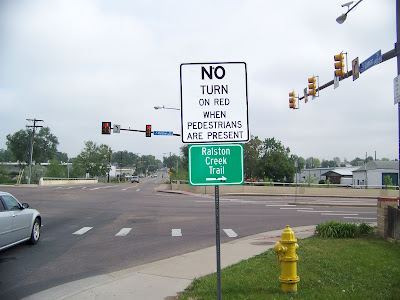
The urban setting quickly gave way to the Ralston Creek bike trail, where we enjoyed nature just a stone's throw from the sounds of highways.
 Ralston Creek is flowing rather high today.
Ralston Creek is flowing rather high today.
Signs of industry just off the trail.
 So green and lush, it's hard to believe we're in Colorado!
So green and lush, it's hard to believe we're in Colorado!
The trail passes under a railroad bridge.
We enjoyed seeing nature and walking in the cool morning.

We had a bit of a shock when we saw Nessie, popping up her head to see who was invading her turf.
 Much to our relief, it wasn't the Loch Ness Monster after all.
Much to our relief, it wasn't the Loch Ness Monster after all.
A bit of Arvada's Gold Rush history. This is located at Gold Strike Park, where there is a lovely bridge and the Ralston Creek Trail connects to the Clear Creek Trail. This is also the site of the first documented gold strike in Colorado in 1850.
 The first of four beautiful pedestrian bridges.
The first of four beautiful pedestrian bridges.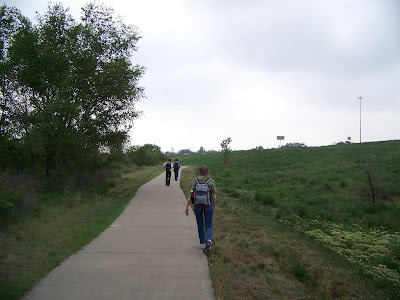
We've left the Ralston Creek trail and we're now on the Clear Creek trail.
 The overpass for I-76.
The overpass for I-76. Clear Creek is especially high today.
Clear Creek is especially high today. After following the bike path under I-76 and seeing examples of local artisans, we once again left the trail for Tennyson Street, which took us past lovely houses and a great view of Lakeside Amusement Park.
After following the bike path under I-76 and seeing examples of local artisans, we once again left the trail for Tennyson Street, which took us past lovely houses and a great view of Lakeside Amusement Park. One-half mile to Tennyson Street.
One-half mile to Tennyson Street. Lovely view of Lakeside Amusement Park.
Lovely view of Lakeside Amusement Park.
Couldn't resist snapping a pick of St. Clair's.
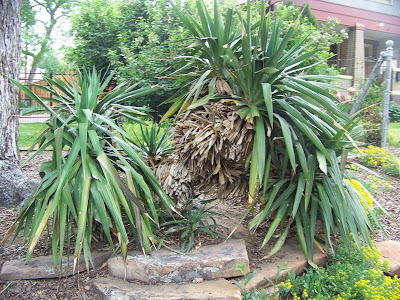 Tennyson passes under I-70 and we followed it to 46th Avenue, which is a lovely, wide and tree-lined street for most of the nearly 2 miles we spent on it. As we neared the city, we began to see more Italian and Mexican restaurants. We spotted more than a few tamale places to which we'd like to return.
Tennyson passes under I-70 and we followed it to 46th Avenue, which is a lovely, wide and tree-lined street for most of the nearly 2 miles we spent on it. As we neared the city, we began to see more Italian and Mexican restaurants. We spotted more than a few tamale places to which we'd like to return.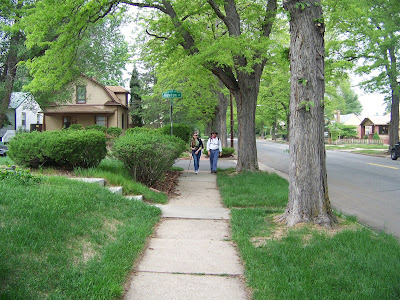 Some of our group were lagging behind.
Some of our group were lagging behind.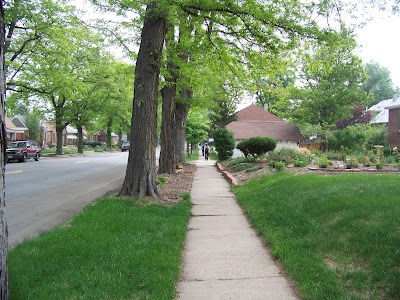 While others were leading the charge.
While others were leading the charge. Who decided to paint the funeral home?
Who decided to paint the funeral home? Thanks for waiting, guys!
Thanks for waiting, guys! The first sighting of downtown. We're a bit over half-way there!
The first sighting of downtown. We're a bit over half-way there! We're getting closer! Union Station can be seen above the end of the street.
We're getting closer! Union Station can be seen above the end of the street. Are we there yet? I'm getting hungry!
Are we there yet? I'm getting hungry! 
We'll have to go back to this place, for sure! But it was getting on towards 11:30 and we had to get to noon Mass.
 Crossing the pedestrian bridge over I-25. Feel the rumble! My husband gave me a kiss as I was looking at the traffic and a trucker blew his horn as he passed underneath. I nearly jumped out of my socks.
Crossing the pedestrian bridge over I-25. Feel the rumble! My husband gave me a kiss as I was looking at the traffic and a trucker blew his horn as he passed underneath. I nearly jumped out of my socks. Ever onward. Despite what some critics have said, I think this is a beautiful bridge and it was incredible to walk across. But on the other side we found...
Ever onward. Despite what some critics have said, I think this is a beautiful bridge and it was incredible to walk across. But on the other side we found... 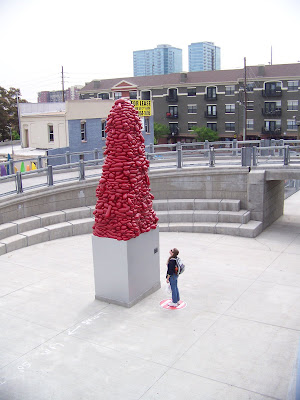
A Christmas tree made out of kidney beans? Some people love it; some people hate it. Here's a video of the artist talking about this work. Straight from the horse"s mouth.
 Yours truly.
Yours truly.
 The next bridge we crossed was this pretty little bridge which crosses the Platte River. Further down, you can see yet another bridge, (the tall white mast) which crosses the train tracks near Union Station and the 16th Street Mall.
The next bridge we crossed was this pretty little bridge which crosses the Platte River. Further down, you can see yet another bridge, (the tall white mast) which crosses the train tracks near Union Station and the 16th Street Mall.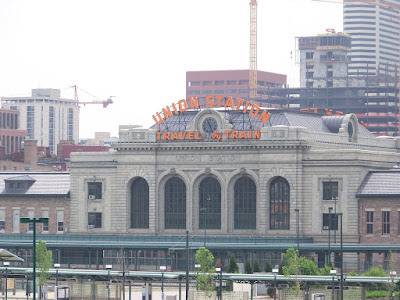 We decided to hitch a ride on the free Mall Ride to get to the end and closer to our final destination of the cathedral. The shuttle covered about 1 1/2 miles in ten minutes, helping us cover the final distance in a shorter amount of time in order to get to Mass on time.
We decided to hitch a ride on the free Mall Ride to get to the end and closer to our final destination of the cathedral. The shuttle covered about 1 1/2 miles in ten minutes, helping us cover the final distance in a shorter amount of time in order to get to Mass on time.
The FREE Mall Ride!
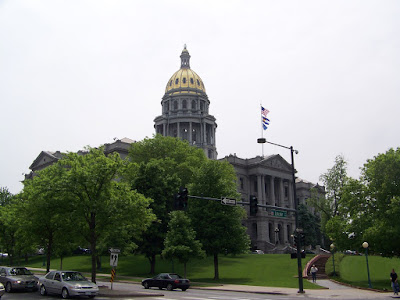
The shuttle dropped us off near the state capitol building with it's gold-leaf covered dome. It was just a short walk up capitol hill to the Cathedral Basilica of the Immaculate Conception, where Pope John Paul II celebrated Mass during World Youth Day 1993.
 A new statue commemorating JPII's visit to the cathedral.
A new statue commemorating JPII's visit to the cathedral.
Schedule of Masses.
 This statue of Mary's Assumption is on the east side of the cathedral.
This statue of Mary's Assumption is on the east side of the cathedral. The interior of the cathedral.
The interior of the cathedral. Finally, here's a shot I took last winter when our homeschool group had a tour of the capitol and we were able to climb up into the dome. You can see the cathedral quite well from up there.
Finally, here's a shot I took last winter when our homeschool group had a tour of the capitol and we were able to climb up into the dome. You can see the cathedral quite well from up there.After Mass and visiting with a friend,* we walked back down 16th Street Mall to look for a suitable place to celebrate our great achievement. We dined at Rock Bottom Brewery, Giovanni and I had their beer on tap, while the kids enjoyed their home-made root beer. The meal was scrumptious and worth every mile (8.5) we walked.
After that fine repast, we walked a couple of blocks to find our bus ready to leave for Arvada. It was a very lovely and enjoyable pilgrimage for Our Lady!
*Funny and true story, and one I hope a dear reader will be able to solve: Our friend was telling us that she spent last Christmastide in Cambridge, England, visiting her son, who is a fellow at Cambridge. While there, she went to a parish church, where she waited in line for confession one afternoon. She took up a conversation with a fellow penitent, who, upon hearing her accent, asked her where she was from. "Denver," she replied.
"Oh, I know someone from Denver," said the penitent.
"Oh, really?" said my friend, thinking to herself that Denver is a pretty large city.
"Yes," she said, and she proceeded to relay our family name to our friend.
Just curious: anyone out there been to confession in Cambridge lately?
Thursday, May 21, 2009
Bet you can't "imagine" what this is about!
Monday, May 11, 2009
Our Lady of Walsingham: National Shrine of Our Lady in England
The Shrine of Our Lady of Walsingham, in Norfolk, East Anglia, is the National Shrine of Our Lady in England. It has been a place of pilgrimage since 1061 and had been considered one of the four most important pilgrimage sites in the middle ages, on par with Rome, Jerusalem and Santiago de Compostela. I visited there recently with my family to see for myself this holy place which came to be known as 'England's Nazareth.'
We arrived providentially in time for noon Mass in the large barn-like Chapel of Reconciliation. The strong smell of disinfectant was in the air as the shrine is in the midst of sheep country and the threat of foot and mouth disease was still high. It was spring, and the lambs were happily romping in the fields near their mothers, oblivious to the threat. Our eight children piled out of our two cars and filed into the church after walking on the obligatory disinfectant mat.
We were welcomed into the church by a group of elderly people and noticed that the only other visitors seemed to be a group of senior citizens on a bus tour. The Mass was quiet and subdued, much like the shrine itself. Great miracles hidden in ordinary appearances.
After the Mass, we ate our picnic lunch on the grounds outside the 14th century Slipper Chapel, which is the only ancient part of the Catholic Shrine. It was a beautiful sunny day and we were able to enjoy our lunch under blue skies with plenty of room to explore. There was also a tea room nearby, which sold food, bottled water and, of course, tea. The very large number of toilets available hinted at the huge crowds which must arrive at the height of the summer. We visited their bookshop and found to our delight, several used books which now grace our shelves, among them a biography of Ronald Knox by Evelyn Waugh. Outside the bookshop is a holy water fountain and we were encouraged to take a bottle of the waters home.
We then visited the small chapel of the Holy Spirit, which has a small area for prayer and a beautiful modern Pentecost mosaic. The Slipper Chapel next door was surprisingly tiny. It houses a modern version of the statue of Our Lady of Walsingham, the original having been destroyed in the Reformation. This statue was venerated by Pope John Paul II when he visited England in 1982. The chapel is too small for daily Mass, but a daily rosary is offered there.
Like many things modern and British, the shrine is understated in its simplicity. There is nothing remarkable about the architecture of the buildings, which are a conglomeration of medieval and modern. The real beauty of the shrine lies in its story; how it came to be and how Our Lady is using it to ignite the flame of faith in England once again.
Our Lady of Walshingham
The Ancient Shrine
During the reign of Saint Edward the Confessor, in 1061, a pious widow named Richeldis de Faverches wanted to pay special homage to the Blessed Mother. After prayer, Our Lady appeared to Richeldis and she was taken in spirit to Nazareth and asked by Our Lady to build a replica of the Holy House of the Annunciation. Richeldis hired workmen to build the house to her specifications, but they were having difficulty with the foundation. She spent the night in prayer and the next morning found the Holy House completed and moved to a new location about 200 feet from the original spot.
In 1150, Augustinian Canons built a priory beside the Holy House. Pilgrims soon began flocking to see 'England's Nazareth.' During its heyday in the middle ages when the Muslims had control of the Holy Land, pilgrims flocked by the thousands to the shrine at Walsingham. Many English monarchs visited Walsingham, which only increased its popularity. Henry VIII made several trips to the shrine and became its greatest benefactor.
The priory at Walsingham has the dubious distinction of being one of the first religious houses in England to sign the Act of Supremacy in 1534, making King Henry VIII head of the Church in England and renouncing the supremacy of the pope. Four years after signing the Act, the priory and its church were both ransacked, looted and demolished. A beloved statue of Our Lady of Walsingham was taken to Chelsea and burned, while the gold and valuables went to fill royal coffers.
All that remains of the original Holy House and priory are the east window of the massive stone church which once surrounded the house and the gatehouse of the priory. These are now part of a museum and there are sometimes processions to the ancient site. They are located in the village of Little Walsingham.
Also located in the village of Little Walsingham are the Anglican shrine to Our Lady of Walsingham, the Anglican replica of the original Holy House, and the pilgrim bureau for the Roman Catholic shrine which handles accommodations for pilgrims.
The Slipper Chapel
The Shrine Reborn
The Catholic Shrine is located about a mile from Little Walsingham and is centered around the medieval Slipper Chapel. This chapel was used by pilgrims on their way to the Holy House in Walsingham and was fortunate enough to escape the destruction which took place in Walsingham in 1538. It is popularly believed that the term "slipper chapel" refers to the pilgrims who would remove their shoes, or slippers, at the chapel to walk the last mile of their pilgrimage barefoot. It may be that the term comes from the old English word "slype," meaning "something in between," because it comes between Walsingham and the rest of the world.
During the time of Catholic persecution in England, the Slipper Chapel was used for various purposes, among them a stable for animals. In 1863, an Anglican, Miss Charlotte Boyd, decided to purchase the Slipper Chapel and restore Benedictine monasticism to the Church of England. After several years of difficulty, she was finally allowed to purchase the chapel. In the intervening years, Miss Boyd became Catholic. Shortly after purchasing the chapel, she donated it to Benedictine monks as a place of prayer for unity in England.
The first post-reformation pilgrimage to the Slipper Chapel and Walsingham took place in 1897. In 1922, the Anglican vicar of Walsingham began to promote Anglican devotion to Our Lady of Walsingham. In 1934, the Slipper Chapel was declared the National Catholic Shrine of Our Lady for England and Wales. Exactly 400 years after the canons signed the ill-considered Act of Supremacy, Walsingham was returned to Our Lady.
Our Lady of Walsingham attracts large numbers of Anglican and Roman Catholic pilgrims to their respective shrines. The Catholic and Anglican bishops have jointly composed a prayer for unity, invoking Our Lady of Walsingham.
This year, September 24th marked the first time that Our Lady of Walsingham has been granted her own feast day on the Church calendar in England. It is a sign of hope and renewal for the Church in England. Father Michael Rear, a priest assigned to the shrine at Walsingham and a convert from Anglicanism, reminded his congregation of the words prophesied by Pope Leo XIII: "'When England goes back to Walsingham, Our Lady will come back to England.' Through this Feast," said Father Rear, "England is coming back to Walsingham."
Planning your visit:
The RC Shrine is opened year-round, but is busiest during the pilgrim season, from Easter to All Saints' Day. If you seek solitude, you will not be disappointed by a wintertime visit. For assistance in locating accommodations near the shrine, contact the RC National Shrine Pilgrim Bureau, Little Walsingham, Norfolk, England NR22 6DB; phone (from the U.S.): 011-44-1328-820217. For general inquiries about the shrine, phone: 011-44-1328-820495 or email: RCNatShrne@aol.com.
For more information:
The official website for both the Anglican and Catholic shrines is: http://www.walsingham.org.uk/. To take a virtual tour of Little Walsingham and the Holy Mile see: http://business.netcom.co.uk/walsingham.
Getting there:
A pilgrim spirit is essential to any visit to the Shrine of Our Lady of Walsingham. It is not easy to get there. The National Catholic Shrine to Our Lady of Walsingham is 117 miles from London by the old pilgrim's way, 27 miles from Norwich, 26 miles from King's Lynn, and 5 miles from Wells-next-the-Sea (a quaint seaside village). There is no train service to Little Walsingham. The nearest train stations are Norwich and King's Lynn. Buses run regularly from London, Norwich and King's Lynn to Little Walsingham via Fakenham. The RC Shrine is 1.3 miles south of Little Walsingham, in a hamlet called Houghton St. Giles.

